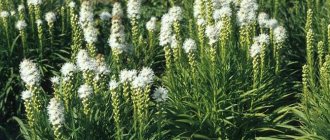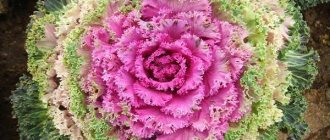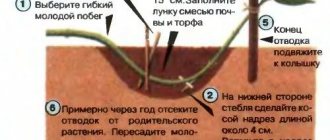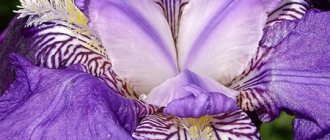Botanical description
The sea buckthorn tree belongs to the sucker family. In the natural environment, it is most often found on the banks of reservoirs (rivers, lakes), where the soils are predominantly sandy with some pebbles. It easily develops in high mountain areas (at an altitude of 2100 m above sea level). The culture owes its Latin name - Hippophae (shine for horses) to the shine that, according to legend, appears on the skin of animals that feed on the leaves of the tree. The Russian name also turned out to be very apt - the fruits are indeed very densely located on the branches, as if they were clinging to them.
The first mention of the plant is in ancient Greek literature. Then its parts were used in folk medicine. But on the territory of modern Russia, typical types of berries began to be grown only in the 19th century. And varietal trees appeared on the plots only in the first half of the next century.
Sea buckthorn develops in the form of a large tree, less often a shrub
The plant can reach a height of 6 m. It has a superficial rhizome, which goes deep only 40 cm. But when it is shallow, it is very branched. The diameter of the crown is 2-2.5 times less than that of the rhizome. Graceful shoots are covered with elongated, rather narrow leaf plates arranged alternately.
Unisexual flowers are small, concentrated, as a rule, on young growth. They are painted in brownish colors and do not represent any decorative value. They bloom at the same time as the leaf buds. Sea buckthorn blooms in late April-early May. With successful pollination, long-awaited fruits are formed in the form of a false elongated or spherical drupe. It takes 3 to 3.5 months for the berries to ripen.
Since sea buckthorn is a dioecious representative of the flora, pollinated by the wind, it is not enough to plant one bush or tree at the dacha. It is imperative to place male and female seedlings side by side. The specimens are planted quite close. But even with a distance of 10 m from the male plant, pollination is successful. One male plant can pollinate several female plants at once. But it is more correct to plant at least two male specimens. Then you won’t have to worry that the only sea buckthorn pollinator will die.
When is it better to plant sea buckthorn - in spring or autumn?
The best time for planting sea buckthorn seedlings is considered to be early spring, when the plant is dormant - until sap flow begins and the buds begin to swell. For planting in spring, seedlings with both closed and open root systems are suitable.
Autumn planting is also acceptable for the crop. In autumn, sea buckthorn is planted with a closed root system (in containers) after the end of leaf fall and at a comfortable temperature of +4 degrees.
Advantages of planting sea buckthorn in spring
- the root system has time to fully strengthen ,
- since the planting site is prepared in advance - in the fall, the pit with fertilizers has time to settle , which has a positive effect on the future harvest,
- when planting sea buckthorn in spring, the first harvest can be harvested a year earlier than when planting in autumn,
- It is easier to identify plants that are difficult to take root in order to provide the necessary additional care in a timely manner.
Advantages of planting sea buckthorn in the fall
- much less time is spent post-planting care
- trees planted in autumn begin to grow 2-3 weeks earlier than those planted in spring,
- in autumn it is easy to determine the quality of seedlings by foliage and other criteria,
- Autumn sales allow you to save money.
The best varieties
To obtain an early harvest of valuable berries, planting material of early ripening forms is chosen. Among the most interesting, gardeners note the following:
“Pearl mussel” is an ultra-early representative of the berry plant that demonstrates stable productivity. It produces an abundance of orange-colored sea buckthorn fruits, suitable for making oil.
“Golden Cascade” - the variety is distinguished by high resistance to diseases and pest attacks. The berries are fragrant. Their weight is 1 g.
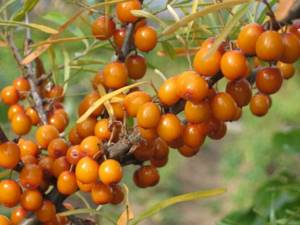
Golden Cascade - vigorous, large-fruited, frost-resistant variety
“Azhurnaya” is a thornless representative. The orange-colored berries are easy to harvest. The marketable weight of elongated cylindrical fruits is 1 g. The variety is drought- and frost-resistant, tolerant of extreme heat.
Mid-season varieties of sea buckthorn are grown everywhere. Despite the later ripening period, they are also popular in cooler regions. The berries have time to ripen, since many varieties are cold-resistant.
Popular:
"Zarevo" is a productive varietal sea buckthorn. Easily tolerates low winter temperatures. Every year we are pleased with the abundant harvest of sour berries.
“Pepper” is a productive form that develops in the form of a low bush. On the outside, the fruit-strewn shoots have a few thorns.
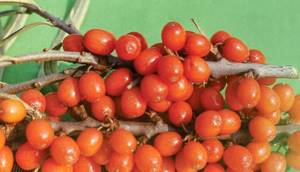
The Perchik variety was obtained in the Botanical Garden of Moscow State University. M.V. Lomonosov
"Little Chanterelle" is a low shrub. Produces an abundance of fruits with high taste in any weather. Does not freeze even in cold winters. Tolerant to specialized pathogenic organisms.
Attention! If you plan to put the cultivation of sea buckthorn on an industrial footing, it is better to give preference to the “Botanical” variety.
In late-ripening varieties, the fruits become sweeter after frost and do not fall off for a long time. The following forms are appreciated among them:
“Elizabeth” is a high-yielding development of Russian selection. The barrel-shaped berries are very tasty with a piquant sourness that only sets off the sweet notes.
“Giant” is a thornless sea buckthorn with sweet and sour egg-shaped berries. The tasty fruits are colored reddish.
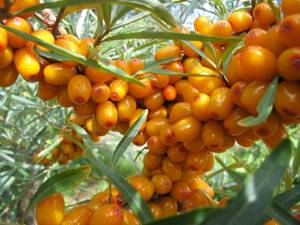
Sea buckthorn Giant - winter-hardy variety with large fruits
“Zlata” is a form with thorny shoots. Not susceptible to developing diseases. Tolerates temperature changes well.
The table shows sea buckthorn varieties popular among gardeners:
| Variety | Maturation | Bush height in meters | Crown | Berry weight in grams | Productivity per bush in kilograms | Oil content in % |
| Golden Siberia | Later | 3 | Medium-compact | 0,8 | 12-22 | 4-6 |
| Nugget | Average | 3 | Medium spreading | 0,7 | 14-20 | 7 |
| Chuyskaya | Early | 3 | Relatively compact | 0,6 | 10-17 | 4-6 |
| Abundant | Average | 3 | Medium spreading | 0,5 | 12-15 | 5 |
| Gift to the garden | Average | 3 | Medium-compact | 0,8 | 10-15 | 4 |
| Gift of Katun | Average | 3-3,5 | Compact | 0,4 | 10-12 | 3,5-7 |
| Orange | Later | 3 | Spreading | 0,6 | 6-8 | 4-6 |
Selection of material for transplantation
Sea buckthorn is a dioecious plant that has male and female flowers. To obtain a rich harvest, it is recommended to plant 2 trees of different sexes on a plot, or one male tree for every 3-5 female trees. Failure to follow this rule will result in a poor harvest. The level of fruit set will increase if the same varieties of sea buckthorn are planted in the garden.
Male plants differ from female plants in appearance. The male ones have a silvery crown, the leaves are flat, and the flowers have a greenish tint. The female crown has a deep green color, cup-shaped leaves, and yellow flowers.
When buying a seedling, you should pay attention to other important features:
- the presence of 3-5 skeletal roots 20 cm long and many thin processes, indicating a developed root system;
- trunk from 30-50 cm in height, with a diameter of at least 5 cm;
- young shoots on the trunk;
- no damage, peeling, cracks, brown spots on the bark;
- minimal or complete absence of thorns.

Berry crop care
The agricultural technology for growing and caring for sea buckthorn is simple. It includes a set of standard measures, ranging from loosening and watering the soil in the tree trunk circle to pruning. If the rules of planting and care are followed, the period of abundant fruiting is about 12 years.
Watering
Despite the heat and drought resistance of sea buckthorn, it loves moisture. During periods of severe drought, irrigation becomes a mandatory procedure. Use settled water, not cold. During the berry picking period, you can sprinkle, washing the shoots from dust.
Top dressing
To form a large tree with high immunity, which will allow you to produce an abundance of tasty berries every year, the crop is regularly fed. The fertilizer application scheme consists of four mandatory feedings:
- In spring, the soil is enriched with nitrogen so that the vegetative mass grows intensively.
- When flowering occurs, potassium humate is added.
- During periods of berry formation and intensive fruiting, phosphorus and potassium are added to the fertilizing composition, which are responsible for normal metabolism and rapid ripening.
Trimming
Another key step in caring for a berry garden is trimming the top of the tree or shrub. Pruning is carried out before intense sap flow begins. They get a haircut for two reasons. In the first four years, the crown is formed in the spring, and later they resort to cutting for sanitary purposes. After the end of the cold season, frost-damaged branches that develop in the center of the crown, as well as dry ones, are removed.
Root shoots can also be cut out while picking ripe berries or in preparation for winter. Since the sea buckthorn tree can grow up to 6 m in height, it is important to regularly trim the tops for ease of harvesting. To carry out the procedure, sharp pruning shears and garden varnish are used to cover the injured areas.
Preparing the site and soil
A favorable area for the plant is an open, windless, sunny place away from fruit crops. To avoid damage to the roots when weeding vegetable crops, it is recommended to plant sea buckthorn near a fence, house, or outbuildings, retreating 1.5-2 meters. Good predecessors are perennial grasses and green manures. Do not plant stone fruit trees or fruit bushes in their place. Having similar diseases, they can infect the plant through the soil.
The culture requires light sandy soil or black soil. Humidity should be moderate; sea buckthorn does not tolerate stagnant water or prolonged drought. The area chosen for it is dug up. For every sq. meter add 2 buckets of humus, 200 g of superphosphate, 50 g of mineral fertilizers, 20 g of potassium phosphate.
On poor soils, the amount of fertilizer is increased by adding 3 buckets of humus, 300 g of superphosphate, 100 g of complex fertilizers, 50 g of potassium phosphate. For acidic soil, use 300 g of lime per square meter. meter. The planting pit is prepared 2 weeks before the intended planting of the crop.
Harvest
The typical species do not bear fruit very profusely. But varietal representatives are distinguished by high productivity indicators. The harvest is formed on the shoots of the berry plant. The berries are arranged very densely. Often the branches are covered with thorns, which requires a lot of time and patience from the gardener when collecting. Cleaning begins at the end of summer.
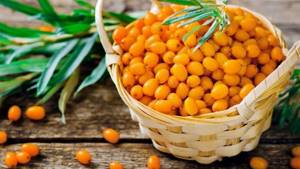
If the purpose of cultivation is to obtain juice, it is better to postpone collection until early autumn
Attention! You can’t delay cleaning too much. The fruits are prone to cracking.
Recommendations for picking sea buckthorn berries:
- the crop is cut from the top to the bottom of the branches;
- when cleaning, put gloves on your hands to avoid injuries from thorns and skin rashes;
- in order not to contaminate clothes, put on an apron: sea buckthorn juice cannot be washed off;
- do not wash the fruits, otherwise some of the juice will be lost - it is better to sprinkle the fruits before harvesting, washing off the dirt from them;
- enamel dishes are used for harvesting;
- Processing of the collected sea buckthorn is carried out on the same day, preventing the release of juice.
There are several cleaning options. The most common and widely used:
- Traditional. With this method, each berry is picked, which takes a lot of time and effort. To facilitate the process, various means are used. You can use a stick with a hook. With its help, the fruits are removed from the shoot, having previously prepared a container into which the berries will fall.
- During subsequent freezing. In this case, it is easier to immediately prune by removing the branches with fruits and immediately placing them in the freezer. Frozen fruit is much easier to remove. It will take much less time, in addition, there is practically no risk of scratching.
- A technique used in the further preparation of juice. Wash your hands well or use gloves. Squeeze the juice directly on the branch, starting from the base and leading to the end of the shoot. The finished juice should fall into a previously placed basin. It takes about 1 hour to produce 5 liters of valuable product.
Types of sea buckthorn
There are only two types of sea buckthorn in the world, but there are countless varieties. In the mountains of Nepal, some provinces of China, as well as Bhutan and India, sea buckthorn is found, and in other countries, sea buckthorn is common - this is what we grow.
It is not difficult to distinguish a bush; once you see it, you will never forget what sea buckthorn looks like. Its thin, grayish leaves, inconspicuous flowers and numerous thorns, of course, cannot be considered beautiful, but the branches strewn with golden fruits can become the pride of any garden.
Reproduction methods
There are many methods for breeding berries: there are both generative and vegetative ones. The first method does not allow preserving varietal qualities, but provides the gardener with numerous planting materials. The latter can serve as a rootstock for subsequent grafting.
Seeds
Sowing of seed occurs in autumn. The latter is carefully distributed over the moistened substrate and covered with film, creating greenhouse conditions. After a month, shoots appear. Picking is carried out after the development of several leaves. It is better to plant the seedlings at a greater distance so that they all have enough nutrients in the soil.
Root suckers
If sea buckthorn is not grafted, this technique is used. It shows good survival rate of the shoots. The procedure is carried out as follows:
- With the arrival of spring, the offspring is separated from the queen cell.
- Add drops and water well.
- When the root system has developed strongly, the sea buckthorn seedling is planted in a permanent place of growth.

Proper propagation of sea buckthorn by root suckers
By layering
Annual branches of sea buckthorn are suitable for performing the technique. The reproduction process looks like this:
- The soil around the tree is fertilized, adding a full range of macroelements.
- Next to the main trunk, grooves are prepared into which the branches of new growth are placed.
- The tops are pinched.
- After the seedlings have germinated 12 cm, they are covered with moistened soil in combination with humus.
- In the spring, the rooted cuttings are transplanted to a prepared area that meets the requirements of sea buckthorn.
Dividing the bush
It is advisable to use this method when moving sea buckthorn to another area. To fulfill it, they choose a crop with a developed rhizome. After this, they dig up the rhizome, remove the old branches, leaving the young ones. Divide into pieces using a sharp shovel. The delenki are planted in selected areas.
Green cuttings
Non-fruiting specimens are suitable for cutting material. The segments are prepared, taking into account the required size - 12 cm. The bottom two leaves are removed, the segments are dipped in the root former solution for 12–15 hours. “Kornevin” has proven itself well. A fertile soil mixture is first prepared by combining peat and sand in a ratio of 1:3. Planting is carried out in a greenhouse. During the period of formation of secondary roots, it is important to regulate the temperature regime, which should not change. The greenhouse is also regularly ventilated by watering the cuttings.
Attention! A month after planting, the greenhouse is removed, having previously accustomed the sea buckthorn to the environment.
Lignified cuttings
They are harvested at the end of autumn and sent to a cool cellar for storage. In the spring, they are divided into 20 cm sections, kept in water for 2-3 days, and then in a root breaker for 24 hours. When the buds and the beginnings of roots appear, they begin planting in the soil mixture. The harvested material is planted in the prepared soil mixture, watered abundantly and mulched with humus. Within a year, healthy seedlings are ready to be transplanted into the garden.
Which area in the garden is suitable for sea buckthorn?
When choosing a place for planting, you need to take into account what will grow near the bush. Garden soil is preferable, since seedlings of this shrub do not feel comfortable near vegetables.
Attention. When choosing a planting site, you need to take into account the fact that the plant’s root system is located close to the surface of the earth, and select places that do not require processing and digging.
The edge of a garden or vegetable garden, a place near a fence, not far from outbuildings - these are the places where the shrub will delight you with flowering and fruiting.
Diseases and pests of sea buckthorn
The berry plant suffers from temperature fluctuations. Humidity also causes a lot of problems when sea buckthorn starts to hurt. Verticillium wilt is a dangerous disease of sea buckthorn. Its seriousness is in an incurable form. As the disease develops, the berries shrivel and dry out. Affected branches should be pruned and burned as a source of infection. If signs appear in the next season, the plant must be uprooted.
The most common harmful insects that feed on sea buckthorn shoots are:
- Sea buckthorn moth. The caterpillars make their way inside the bud and feed on the pulp. Spraying with Chlorophos will help destroy harmful insects. This can be done before the buds open. A similar technique is used to protect against sea buckthorn flies. The latter, in case of inaction on the part of the gardener, can destroy the entire crop.
- Sea buckthorn aphid. It feeds on the leaf blades of the berry bush. They quickly turn yellow and fall off. Garlic peel treatment is used as a protection measure. If the colonization is intensive and there is a lot of time before harvesting, it is better to resort to spraying with an insecticidal pesticide - “Karbofos” or an analogue.
Planting and caring for sea buckthorn is simple. The main thing is systematicity. If a gardener puts in just a little effort, he can expect a consistently large harvest every year.
Care after transplant
Sea buckthorn is an unpretentious plant; caring for it involves regular watering, fertilizing, and loosening the soil. However, after the transplant she requires special attention.
- Water 1-3 buckets regularly for a month after transplanting.
- If the soil settles, add soil to the original level.
- Mulching the soil using sawdust, peat, and humus will retain moisture and create an optimal microclimate for seedling adaptation.
- For preventive purposes against diseases and pests, spray the seedling with a 3% solution of copper sulfate and Fitoverm .
How to properly plant sea buckthorn in autumn
Autumn planting is carried out if the seedling is taken from the same area where it will be planted . If a young shoot is brought from the southern regions, it can wake up in January - February, and frosts will destroy it. Choose plants with a closed root system, healthy and strong.
Advice. When planting in autumn, it is better to plant several specimens in case some of them freeze out.
To plant a tree, you will need planting material, a shovel, a rake, water for irrigation, organic and mineral fertilizers to provide the young plant with nutrients. It is better to choose young specimens no more than two years old.
Step-by-step instruction:
- The planting hole is prepared three weeks in advance. If the soil is poor, add compost and dig it onto the bayonet of a shovel. If it is heavy and clayey, they dig it up, adding sand.
- Next, they dig a hole 50 cm wide. The depth should be 10-12 cm lower than in the nursery. The top and bottom layers of soil are folded separately.
- Fill the hole with a nutritious soil mixture: top fertile soil layer (1 part), humus (1 part), wood ash (1 cup), double superphosphate (200 g).
- Water and leave in this form for 1-2 weeks.
- Then a mound of fertile soil is poured, a seedling with an open root system is placed on the mound, and the roots are straightened. If the root system is closed, simply place a lump of earth in the center of the hole.
- Cover the tree with soil. At the same time, shake the trunk slightly so that the soil is evenly distributed between the roots and voids do not form. Lightly press the soil with your hands.
- Watered. A tree trunk circle is formed. The root collar of the tree should be at soil level.
A little about sea buckthorn propagation
The crop can be propagated using cuttings, seeds, suckers or grafting:
- The easiest way to grow a new shrub is to use a shovel to separate the offspring that grew next to the mother one. Next, the offspring needs to be watered, and with the onset of spring, planted in open ground;
- Seeds are practically unable to convey the qualities of varietal shrubs. If this method of propagation is used, then it is worth doing it in the spring . Before planting, the seeds must be soaked in water for 5 days. The soil must be well heated. Holes for planting should be 5-7 centimeters deep;
- When propagating by cuttings in late autumn, you need to cut one or two-year-old shoots, which should overwinter at a temperature of 0 - +2 °C. Next in the spring, the cuttings should be cut 15-20 centimeters in length and deepened into the soil by 10 centimeters, the buds should remain above the surface of the ground. If you water the cuttings daily, then around the autumn the seedlings will have time to take root;
- Grafting is one of the most unpopular types of reproduction. Usually, a male cutting is used for grafting onto a female tree to pollinate if it is not possible to plant a full-fledged tree nearby.
How to fertilize
Sea buckthorn is not harmful in terms of fertilizer. Due to its wide root system, it independently finds nutrients in the soil and there is no need to fertilize it for the first years.
If desired, for better formation of new shoots, plants in the spring can be fertilized with urea (up to 30 g per 1 bucket of water). Each tree or bush is watered with half a bucket of liquid.
It is advisable to fertilize young growth with organic fertilizers. For example, stir humus in water and water the plant around. This procedure should be carried out once every three years.
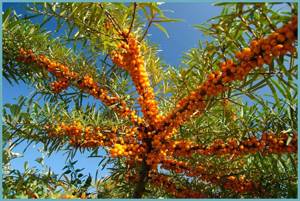
Sea buckthorn loves moisture, so you should water it infrequently, but with plenty of water.
By paying such attention to the plant, sea buckthorn will bring a good, fertile harvest every year and will not interfere with other plants with its roots. Be treated, enjoy the beauty of this plant and do not forget the features of caring for it!


